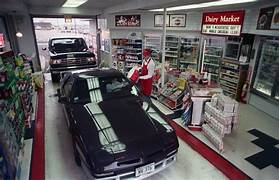The year 1946 marked a significant milestone in the history of the United States as it witnessed the inception of the first drive-through banking service. This innovation revolutionized the way people conducted their financial transactions and ushered in a new era of convenience and efficiency in the banking industry. The concept of a drive-through service had already gained popularity in the fast-food industry, with drive-in restaurants becoming a common sight across the country. The idea of offering a similar level of convenience in banking services emerged as a natural progression, aimed at simplifying the lives of American consumers. The first drive-through banking service was introduced by the Exchange National Bank of Chicago, now known as the Metropolitan Bank. On July 12, 1946, the bank opened its "banker's window" to the public, allowing customers to conduct their financial transactions from the comfort of their automobiles. This marked a significant departure from traditional banking practices, which required customers to enter a bank's premises, stand in line, and complete their transactions at a teller window inside the bank. The introduction of drive-through banking brought numerous advantages to both customers and banks. Customers appreciated the convenience and time-saving aspect of this new service. They could now perform basic banking tasks like making deposits, cashing checks, and conducting other transactions without leaving their cars. This was particularly useful for those with mobility limitations, parents with young children in tow, and busy individuals who valued the time-saving aspect of the drive-through service. For banks, the adoption of drive-through banking led to increased customer satisfaction, higher efficiency, and cost savings. By reducing the foot traffic inside the bank, it minimized the need for additional teller windows and physical space. This innovation allowed banks to serve more customers in less time, resulting in shorter wait times and improved customer service. Furthermore, it provided an opportunity for banks to enhance their brand image as modern and customer-focused financial institutions. The success of the Exchange National Bank's drive-through service quickly caught the attention of other financial institutions across the country. Banks in various states started implementing their own drive-through banking facilities, contributing to the widespread adoption of this convenient service. Drive-through banking's popularity continued to grow over the decades, and it evolved to offer a wider range of services. In addition to the traditional teller windows, banks introduced drive-through ATMs, which allowed customers to perform cash withdrawals, balance inquiries, and other electronic transactions from the comfort of their vehicles. The drive-through became a hub for not only routine banking but also extended services, such as making mortgage payments, purchasing traveler's checks, and even obtaining financial advice from on-site experts. Today, drive-through banking has become an integral part of the modern banking experience, with most financial institutions offering this service. It has adapted to technological advancements, with the incorporation of video banking, touchscreen kiosks, and other innovations to further enhance the customer experience. Drive-through banking has become a symbol of convenience and efficiency in the banking sector, catering to the ever-evolving needs of customers in an increasingly fast-paced world.
1946 U.S.A. – – First Drive Through Banking
